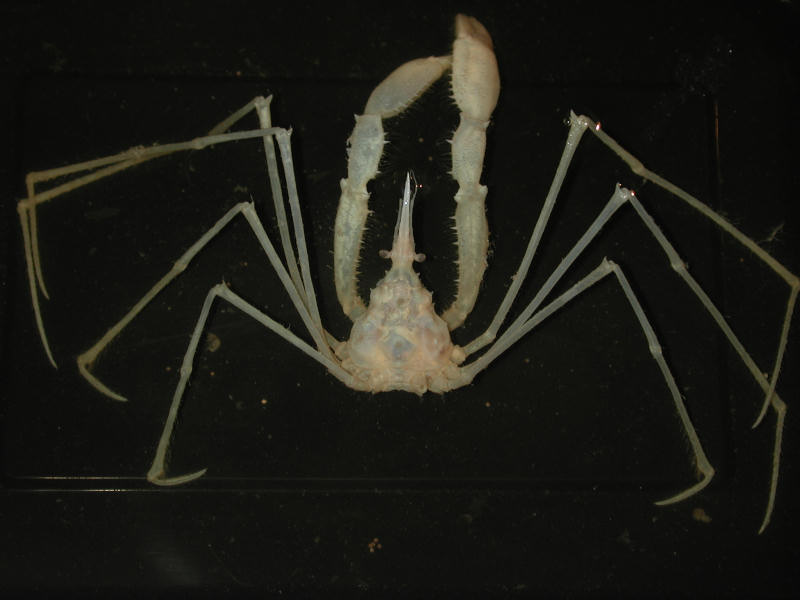Slender spider crab (Macropodia tenuirostris)
Distribution data supplied by the Ocean Biodiversity Information System (OBIS). To interrogate UK data visit the NBN Atlas.Map Help
| Researched by | Rose Edwards | Refereed by | Admin |
| Authority | (Leach, 1814) | ||
| Other common names | - | Synonyms | - |
Summary
Description
Recorded distribution in Britain and Ireland
Common around the British Isles.Global distribution
Recorded from Faeroes Bank southwards to Portugal.Habitat
Macropodia tenuirostris has been recorded in depths from about 9 m to 97 m on muddy to hard substrata, in estuaries, and also on colonies of Sertularella spp. at depths down to 300 m.Depth range
-Identifying features
- Triangular shaped carapace.
- Reddish brown in colour.
- Rostrum thick and very long, deflected slightly upwards.
- Second to fifth pair of legs very long and slender.
Additional information
The arrangement of spines on the upper surface are diagnostic of species of Macropodia (see Ingle 1980 & 1996 for further details).Listed by
- none -
Bibliography
Bradshaw, C., Veale, L.O., Hill, A.S. & Brand, A.R., 2002. The role of scallop-dredge disturbance in long-term changes in Irish Sea benthic communities: a re-analysis of an historical dataset. Journal of Sea Research, 47, 161-184. DOI https://doi.org/10.1016/S1385-1101(02)00096-5
Crothers, J. & Crothers, M., 1988. A key to the crabs and crab-like animals of British inshore waters. Somerset, England: Field Studies Council. [AIDGAP guide, no. 155.]
Hayward, P.J. & Ryland, J.S. (ed.) 1995b. Handbook of the marine fauna of North-West Europe. Oxford: Oxford University Press.
Howson, C.M. & Picton, B.E., 1997. The species directory of the marine fauna and flora of the British Isles and surrounding seas. Belfast: Ulster Museum. [Ulster Museum publication, no. 276.]
Ingle, R.W., 1980. British Crabs. Oxford: British Museum (Natural History), Oxford University Press.
Ingle, R.W., 1996. Shallow-water Crabs, (2nd edn). Shrewsbury: Field Studies Council. [Synopses of the British Fauna, no 25]
JNCC (Joint Nature Conservation Committee), 1999. Marine Environment Resource Mapping And Information Database (MERMAID): Marine Nature Conservation Review Survey Database. [on-line] http://www.jncc.gov.uk/mermaid
Salman, S.D., 1981. Larval development of Macropodia tenuirostris (Leach) (Crustacea, Brachyura, Majidae), reared in the laboratory. Journal of Natural History, 15, 931-938.
Van Noort, G.J. & Adema, J.P.H.M., 1985. The genus Macropodia Leach, 1814 in the North Sea and adjacent waters, with the description of a new species. Zoologische Mededelingen, 59, 363-379.
Datasets
Centre for Environmental Data and Recording, 2018. IBIS Project Data. Occurrence dataset: https://www.nmni.com/CEDaR/CEDaR-Centre-for-Environmental-Data-and-Recording.aspx accessed via NBNAtlas.org on 2018-09-25.
Kent Wildlife Trust, 2018. Kent Wildlife Trust Shoresearch Intertidal Survey 2004 onwards. Occurrence dataset: https://www.kentwildlifetrust.org.uk/ accessed via NBNAtlas.org on 2018-10-01.
NBN (National Biodiversity Network) Atlas. Available from: https://www.nbnatlas.org.
OBIS (Ocean Biodiversity Information System), 2025. Global map of species distribution using gridded data. Available from: Ocean Biogeographic Information System. www.iobis.org. Accessed: 2025-07-12
Citation
This review can be cited as:
Last Updated: 16/11/2005



